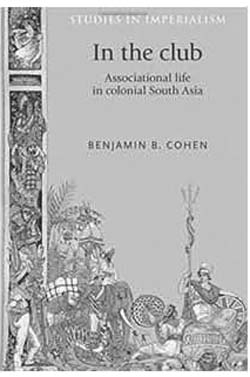In the Club is a welcome addition to the study of colonialism and colonial bourgeois sociality in South Asia. The book is not so much a history of clubs as it is a study of the formation and articulation of social relations in clubs. Though the network of clubs played a significant role in the unfolding of colonialism in South Asia, it is still a relatively ignored area in the historiography of colonial encounters. In fact, this is the first book-length survey of clubs in this part of the world. It is not dedicated to a particular city. Cohen appears to follow the club wherever it has left archival traces. Often, such works of trans-regional ambition are seen to compromise with the ‘context’. A skilled crafting of those volumes then depends on the use and inter-referencing of footnotes in the text. The author may consider this suggestion when he brings out a second edition of the book.
Divided in seven thematic chapters, In the Club claims to extend Mrinalini Sinha’s sophisticated formulation of the European club as a ‘unique institution of colonial civil society’ occupying ‘an intermediate zone between both metropolitan and indigenous public spheres’ (quoted on p. 17). In the lucidly written Introduction, Cohen goes against the long-held notion of the club culture as what Robin Jones has called the ‘bastions of racial segregation’ (quoted on p. 17) and proposes to ‘complicate and refine such views by demonstrating that club culture was far more nuanced than has been assumed’ (p. 17). Cohen suggests that such a reading of the club interrogates and reorients some of the longstanding ‘markers of South Asian chronology’ (p. 17). Cohen further suggests that by following the club networks one can ‘re-map our image of the subcontinent from one with national boundaries to one redrawn along alternative patterns of association’ (p. 18). As the argument unfolds in the book, Cohen’s re-mapping of the region comes close to the map of the British Empire in South Asia. It appears that clubs closely followed the circulation of the white-collar imperial labour force and the business class. As this labour force became racially heterogeneous, so did the membership of the clubs. The limited encounter between races that clubs facilitated could be seen to have consolidated the idea of an imperial ruling class in South Asia. This race-class dialectic is implicit in Cohen’s rich narrative, though it seems that he has not fully considered its dynamics in the book’s argumentative structure.
Cohen shows how clubs developed shared sets of rules and bylaws within the overall legal network of the Empire (Chapter I). The shared ideological as well as logistical operation of clubs consolidated the idea of civil association in South Asia. Cohen notes that most clubs tended to copy the rules and bylaws from the United Service Club—the premier association of Her Majesty’s military officers. The fact that it became the modular form for other clubs, forces us to consider the military foundation of the colonial civil society.
Continue reading this review

